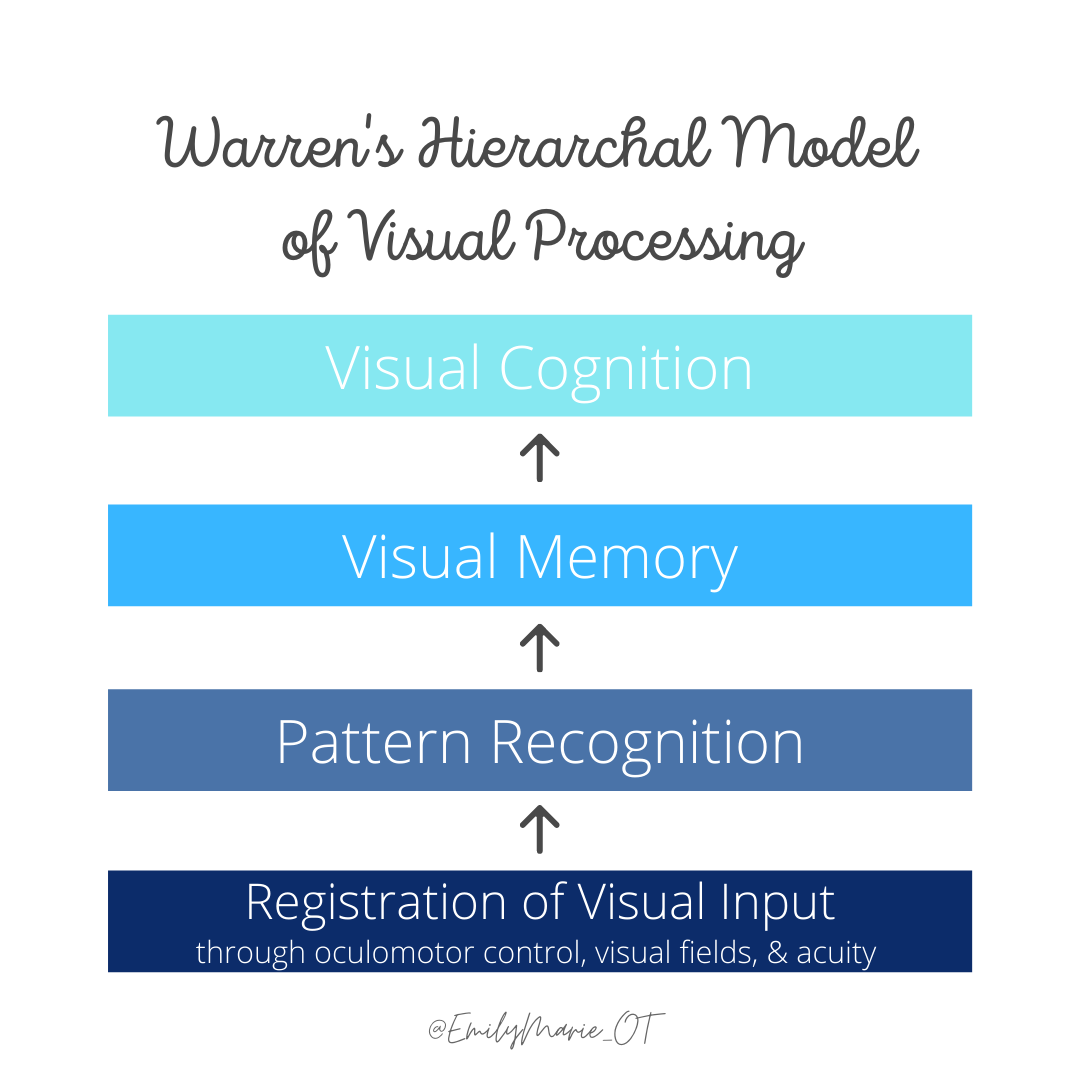Hierarchy of Visual Perceptual Skills
As I’ve been discussing Visual Perceptual skills on Patreon this month, a mentee had the question, “Is there a hierarchy of visual perceptual skills?”
Using my clinical reasoning and past knowledge, I understood that visual memory is essential to build other visual perceptual skills. You must know what you’re looking at before trying to discriminate, finish, or find it.
But what about after that? And what prerequisites are there for visual memory? Well, I did a little digging into my grad school books, and rediscovered Warren’s Hierarchal Model of Visual Processing.
Warren’s Hierarchal Model of Visual Processing breaks down the four building blocks of visual perceptual skills. A breakdown or barrier in any foundation skill will impact visual perception. While originally designed for adults, the fundamentals hold true for all intervention.
At the most basic level is the registration of visual input through oculomotor control, visual fields, & acuity. This means that if a child has difficulties with oculomotor skills (ie. Convergence/divergence, eye teaming, saccades, tracking/visual pursuits, etc), they may have difficulties with drawing, writing, reading, and math that require the use of visual perception. Addressing acuity (ie. 20/20 vision) is also important. Imagine trying to copying a drawing without wearing prescribed glasses or contacts. That burred mess is sure to give me a headache! Last, it is crucial to understand what a child sees. Are they using their full visual field or just part? Neglecting or being inattentive to certain fields of vision will impact the amount of information a child can intake in their environment and how it is processed to be meaningful. The ability to fluidly scan the environment will also impact the information taken in be analyzed by the brain. All three component skills, oculomotor control, visual fields, and acuity, need to taken in all information in the environment before it can be processed and perceived.
Next comes pattern recognition. A child must be able to problem solve, predict, and use working memory information to complete and follow a pattern. It also involves understanding the specific detentions and making of shapes and objects.
Build upon pattern recognition is visual memory. This is the first of the typical mentioned visual perceptual skills. Visual memory is the recognition of shapes and forms “in the mind’s eye” (Zoltan, 2007). A child needs to be able to recognize shapes, images, objects, forms, and characters before asked to search for them in a hidden picture, match them to difference sizes, or comprehend the incomplete form.
Last comes visual cognition. This is the functional use of vision and perceptual skills. It combines discrimination, closure, spatial relations, sequential memory, figure ground, form constancy. Visual cognition is the combination of using learned knowledge, executive functioning skills, sensory processing and modulation, and vision in interaction with one’s environment. It is the highest level of the hierarchy.
Using a bottom up approach is crucial to improve visual perceptual skills for a child.
Address the building blocks through your interventions first. Then build onto the hierarchy for improvements in more advanced visual perceptual skills. This is the key to progress and success!
Emily is a pediatric occupational therapist providing community and home-based OT services in the Greater Philadelphia area, PA. She is a mentor for School-Based Occupational Therapists, offering one-one-one sessions to grow in confidence and skills. Emily Marie OT LLC strives to empower all to achieve their full potential.


